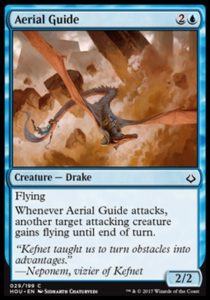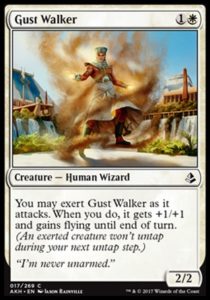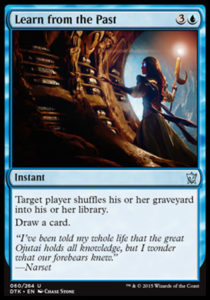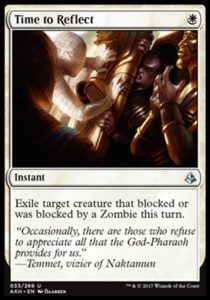Ever since Phantasmal Mount, creatures have been giving each other flying, usually at an awful rate. Ever since Tempest, Wind Drake has been a solid Limited creatures, usually one of blue’s best common creatures. Today, we finally have a common which combines the two: a Wind Drake that grants flying.
Okay, so it’s not the most dramatic occurrence, but there’s much to be gleaned from this increase in power level.

Drake Creep
It’s no secret that creatures have gotten a lot stronger since 1993. Back in the good ol’ days, creatures were weak, cost more than the removal spells used to deal with them, and were outclassed by the many potent combos around. Nevertheless, they were always the lifeblood of Limited, since they provide value every turn they’re on the field.
As creatures have gotten better. answers have matched up with them worse—each creature being better means that more creatures demand answers. This trend is bolstered by the weakening of common removal. We’ve seen this progression accelerate in recent years, from Chasm Drake in M12 and Trained Condor in M14, to Gravity Negator in Oath of the Gatewatch and Mistfire Adept in Fate Reforged, as well as cards like Eddytrail Hawk in Kaladesh. Creatures are giving more bang for their buck, and Aerial Guide is not only a strictly better Wind Drake and Trained Condor, but it’s in a much, much more aggressive format than Trained Condor was (M14’s best common was Divination and one of its best bombs was Opportunity). Naturally, Aerial Guide should be amazing, right?

An Interesting Paradox
In an aggressive format, creatures predisposed to attack get better, as do creatures which make attacking easier. Aerial Guide does both of those things, and at a very good rate—after all, Wind Drake is a fine attacker on its own. The problem is that if creatures are so strong and aggressive that they can’t be blocked profitably, then extra bells and whistles like evasion and granting evasion become dead weight, decreasing a card’s base stats more than they increase its utility. We saw this in Kaladesh, where Thriving Rhino completely outclassed Wind Drake as a three drop and cards like Peema Outrider made it very difficult for blue to block on the ground and race in the air. Fellow Hipster Carrie even wrote about it.
Aerial Guide is a much stronger card than Wind Drake and has done good work at prerelease and weekends, but it is still below rate when compared with creatures with Exert. Gust Walker and Khenra Scrapper don’t need help attacking and even Solitary Camel races better. When blocking is bad, then Aerial Guide is a below-rate attacker.
For aggressive tempo cards like Aerial Guide, there is a sweet spot. The format needs to be aggressive enough that evasive creatures are good—M14 was so slow that Trained Condor was a mediocre card. However, the format can’t be so aggressive that blocking is too difficult—as was the case in Amonkhet. Fortunately for Aerial Guide and lovers of tempo decks, Hour of Devastation might provide the perfect environment. Wall of Forgotten Pharaohs showed a lot of promise this weekend and could be exactly the defense needed to both apply pressure while staving off damage. It matches up poorly against Afflict, but Afflict creatures are much easier to block and trade with than Exert creatures (they are undercosted for their size for the same reason that Aerial Guide is—their ability to force in damage).

Looking Back to See Ahead
It might seem strange to dwell on the history of relatively mundane commons, but there’s value to be gleaned. Understanding what came before, how it was good or bad, and why, is key to understanding what is possible and preferable now.
A keen-eyed observer (or Aven) would have noticed that Wind Drake was worse in Kaladesh than it was in Dragon’s Maze, and that its stock had already been steadily falling. Flying is still a powerful ability, but medium-size creatures have gotten better at racing evasive creatures (and WotC has continued to print mechanics which encourage attacking, rather than turtling up—a good thing, since games that end are better than games which don’t). The advent and proliferation of Menace means that flying creatures have to compete with more evasive creatures, straining their decks’ ability to block even further while mitigating the thing that makes them special.
Looking ahead, I expect two things to happen in the not-too-distant future. First, I expect to see even better common flying creatures than Aerial Guide. We could see the return of Phantom Monster, or a Cloud Spirit with no drawback. Secondly, I expect to see a Wind Drake that has a synergistic ability, rather than just a solid (but generic) one, like Benthic Infiltrator or Jeskai Windscout. Aerial Guide just shows us that Wizards is aware that the world is ready for much better Wind Drakes, and I bet it’s just the tip of the iceberg.

Wrapping Up
Hopefully this deep dive into Aerial Guide has been interesting, if not helpful. If you’re interesting in thinking about Magic more like a game designer, or you want to try and get an edge on the competition, I encourage you to pick a card, any card, and see what came before. What is the precedent for this card’s effect? Why do you think certain design decisions were made when they were? What consequences do they have? How did context shape the power of the design? What do you expect will be done going forward?
And, of course, don’t forget to test your hypothesis with some good, ol’ Magic. There’s no substitute for playtesting, after all, and there’s no substitute for Magic: the Gathering.
And, as always, thanks for reading.
—Zachary Barash
Zachary Barash is a New York City-based game designer. He works for Kingdom Death: Monster, has an MFA in Game Design from NYU, and does freelance game design.
His favorite card of the month is Mark of Mutiny. It’s not the most beginner-friendly design, but it teaches players that Threatens are for ending the game, not doing a medium amount of damage. If you play the card as a finisher, its downside is actually upside, and that inversion is really cool.

